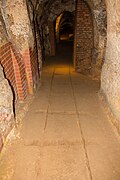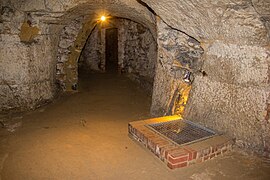Felsenkeller (Schwandorf)

In the Upper Palatinate town of Schwandorf von Bayern there is a listed (D-3-76-161-73) labyrinth of rock cellars, mainly in the Weinberg and Holzberg, but also in the Fronberg district .
So far, Keller found about 130 in the Dogger - sandstone has been carved. These cellars are partly next to each other, partly one above the other. Your system did not follow a superordinate plan, but were created in different periods and for different purposes.
history
The presumed start of the tunnel construction is given around 1380. This may have to do with the construction of search tunnels for iron ore mining in Upper Palatinate . Remnants of a track for a lorry at least prove the stone quarrying inside the mountain. But it could also have been an underground quarry. In later times the cellars were used for beer production, as beer was produced here in the 16th century using the long process of cold fermentation . This required deep cellars with a constant temperature of 10 degrees or less. A Schwandorf beer recipe from 1549 proves that the local brewers used this method early on. It is also used as an ice cellar .
After the decline of the communal brewing industry, the privately owned cellars were also used to store food from the middle of the 19th century. This called for cellar thieves on the scene in the 1930s, who connected some of the previously separate cellar systems to one another by breaking through masonry and rock walls and crevices. During the Second World War , some of the tunnels were converted into air-raid shelters and hospital rooms. On the night of the bombing of April 17, 1945, 6,000 people sought refuge in the rock cellars. After the war, some cellars were filled with rubble. Today's publicly accessible labyrinth follows the path of cellar thieves. To do this, around 500 cubic meters of overburden had to be removed from the cellars, the narrow holes had to be widened to form passageways and brick arches had to be erected as security.
Todays use
Today, 60 rooms of the complex are open to the public as part of guided tours, with and without a play. In Advent, the theater association regularly performs fairy tales. The individual scenes take place in different basement rooms. Cultural and museum events are offered in a rock cellar on Fronberger Straße. A cellar owner has converted his rooms into a restaurant.
geology
The basement rooms carved into the rock offer numerous outcrops and faults ( fissures ) in the Great Dane sandstone of the Aalenium . Some of these natural fissures were artificially widened by the basement thieves in order to get to lower floors. The cellars were designated as geotopes by the Bavarian State Office for the Environment and classified as valuable .
photos
Use as a beer cellar
Gap widened by the basement thieves
Natural chasm in the Dogger
Exposure in the Dogger
literature
- Bernhard Häck: galleries and rock cellars in the Schwandorf underground. In: Annual volume on culture and history in the district of Schwandorf , Vol. 11, pp. 59–74.
Web links
- Schwandorf rock cellar labyrinth
- Historic rock cellar Schwandorf. Schwandorf underworld
- The Schwandorfer Felsenkeller
Individual evidence
- ^ Historical rock cellars Schwandorf
- ↑ Bavarian State Office for the Environment, Geotop Felsenkeller in Schwandorf (accessed on January 19, 2016)










